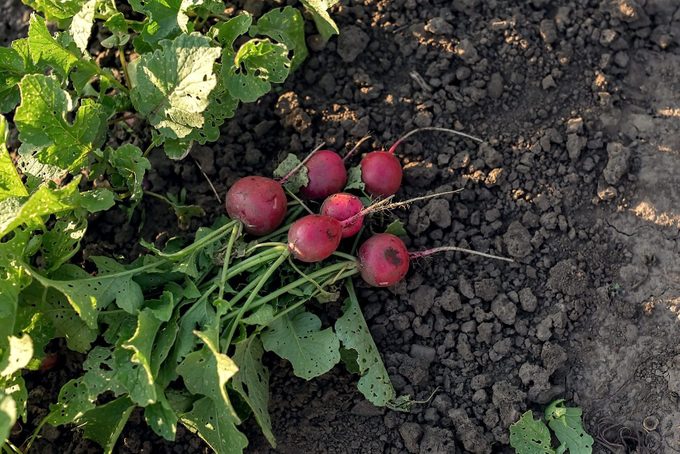

Did you know that on December 23 each year, they celebrate the Night of the Radish, La Noche de Rábanos, in Oaxaca, Mexico? Local artists create sculptures out of radish roots as part of the festivities. They grow huge radishes to carve, bigger than you are likely to grow in your garden. You’re more likely top grow smaller spring radishes, but if you want, you can also grow fall or winter radishes, too!
On This Page
Types of Radishes
There are two main types of radishes, spring radishes and fall or winter radishes.
Spring radishes
Spring radishes are the typical radishes you’ll find year-round in the grocery stores. They are usually small, round and red, and can be ready to harvest in as little as three weeks from sowing seeds. They grow best in cool, spring weather. Once the days are warmer, these radishes will bolt and send up a flower stalk. At that point, the radishes will no longer be good to eat. Varieties of spring radishes include:
- ‘Cherry Belle,’ the classic red radish.
- ‘Easter Egg,’ a blend of white, pink, red and light purple radishes.
- ‘French Breakfast,’ my personal favorite — which produces red cylindrical roots with white tips.
Fall or winter radishes
Fall or winter radishes are grown later in the year, have much larger roots, take longer to grow than spring radishes and can be stored for a longer period of time. They need the shortening days later in the season to produce good roots. They are often referred to as daikon radishes. Varieties of fall or winter radishes include:
- ‘Minowase,’ the classic daikon radish that produces long white roots.
- ‘Watermelon,’ a large round radish with a red interior.
- ‘Black Spanish,‘ a large round radish with a white interior.
How to Plant Radishes
All radishes are best grown from seed sown directly in the garden. Radishes need loose, loamy soil for good root development and prefer a sunny location. Spring radishes can also be grown in containers.
Spring radishes
Sow seeds for spring radishes four to six weeks before the predicted last frost in the spring. Sow in rows, spacing seeds one inch apart, covering with half an inch of soil. Once seedlings emerge, thin to two inches apart to allow room for roots to form. To make planting easier, you can also buy radish seeds on seed tape. Lay the tape in the row, cover, water and wait.
Fall or Winter Radishes
Sow seeds for fall radishes later in the summer, about eight to 10 weeks before the predicted first frost date. Because winter radishes vary in mature size, check the instructions on the seed packet for how far apart to space the seeds and how long they take to grow and mature.
How To Grow and Care for Radishes

Watering
The general rule for watering most vegetable garden crops applies to radishes, too. If your garden doesn’t get an inch of rain in a week, you may need to water it, but avoid overwatering, which can cause roots to rot.
Weeding
Start by removing weeds before sowing the seeds. For spring radishes, they’ll grow quickly enough that they’ll beat the weeds. For winter radishes, remove weeds carefully, so you don’t disturb the roots.
Thinning
Follow instructions on the seed packet to thin seedlings to allow for good root development. Fall or winter radishes will be spaced further apart than spring radishes. Spring radish seedlings are edible.
Fertilizing
If your garden has good soil with added compost, additional fertilizer is generally not required to grow radishes.
Preventing insects
Radishes may occasionally be bothered by a few insects, including flea beetles, cutworms and radish root maggot, the larval stage of a tiny fly. If you’ve had problems with these types of insects in your garden in the past, you can use a fabric row cover to keep the insects from getting to the radishes. Also, practice crop rotation by planting radishes in different parts of the garden each year.
How to Harvest Radishes
Spring radishes
You can harvest spring radishes sometimes just three weeks after sowing, depending on the variety. Gently pull out the entire radish plant to harvest. Wash them off, trim off the top and the bottom of the root and enjoy eating fresh, crunchy radishes.
Fall or winter radishes
Fall or winter radishes will be much bigger than spring radishes when ready to harvest, but are also harvested by gently pulling them out of the ground. If they don’t come up with a good tug, gently dig them out to avoid damaging the roots. Fall or winter radishes can be stored for up to a month in the refrigerator. The outside skin will be thick and tough and should be peeled off before eating.
Did you miss our previous article…
https://tophouseimprovement.com/how-to/what-you-need-to-know-about-pto-wood-chippers/
